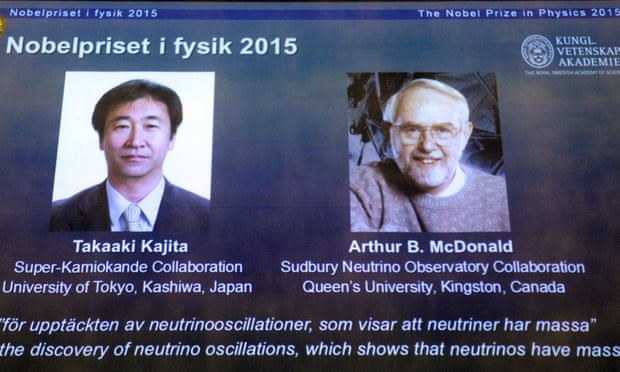
The Nobel was awarded "for the discovery of neutrino oscillations, which shows that neutrinos have mass”.
"The discovery has changed our understanding of the innermost workings
of matter and can prove crucial to our view of the universe," said a
press release.
The winners will share the 8 million Swedish kronor (about $960,000)
prize money with one half going to Arthur. McDonand and the other to Takaaki
Kajita.

Each winner will also get a diploma and a gold medal at the
annual award ceremony on Dec. 10, the anniversary of the death of prize
founder Alfred Nobel.

Takaaki Kajita is from the University of Tokyo. Mr. Kajita discovered
that neutrinos from the atmosphere switch between two identities when
coming to Japan's Super-Kamiokande neutrino detector.
Arthur McDonald is a professor emeritus at Queen’s University in Kingston, Canada. The research group Mr. McDonald demonstrated that the neutrinos from the Sun were not disappearing on their way to Earth. Instead they were captured with a different identity when arriving to the Sudbury Neutrino Observatory.
Note
2014 Nobel Prize for Physics
The first Nobel Prize in Physics was awarded to a German physicist Wilhelm Conrad Röntgen for the discovery of X-Rays
A maximum of 3 Nobel Laureates and 2 different works may be selected for the Nobel Prize in Physics
The Nobel laureates are selected by the Nobel Committee for Physics,a Nobel Committee that consists of 5 Members elected by The Royal Swedish Academy of Sciences
Till 2014, a total of 198 individuals have been awarded the Nobel Physics prize.
Who created the Nobel Prizes?
A maximum of 3 Nobel Laureates and 2 different works may be selected for the Nobel Prize in Physics
The Nobel laureates are selected by the Nobel Committee for Physics,a Nobel Committee that consists of 5 Members elected by The Royal Swedish Academy of Sciences
Till 2014, a total of 198 individuals have been awarded the Nobel Physics prize.
Who created the Nobel Prizes?
The prizes in medicine, physics, chemistry, literature and peace were
established by the will of Alfred Nobel, a wealthy Swedish industrialist
and the inventor of dynamite. The first awards were handed out in 1901,
five years after Nobel’s death.
The economics award officially known as the Bank of Sweden Prize in
Economic Sciences in Memory of Alfred Nobel wasn’t created by Nobel, but
by Sweden’s central bank in 1968.
Though it’s handed out along with the other prizes and the criteria for
selecting winners are the same, it’s not a Nobel Prize in the same
sense.
Who can nominate?
Thousands of people around the world are eligible to submit nominations
for the Nobel Prizes. They include university professors, lawmakers,
previous Nobel laureates and the committee members themselves.
The Norwegian connection
The Nobel Peace Prize is presented in Norway while the other awards are handed out in Sweden. That’s how Alfred Nobel wanted it
The peace prize committee is the only one that regularly rewards
achievements made in the previous year. According to Nobel’s wishes,
that prize should go to “the person who shall have done the most or the
best work for fraternity between nations, for the abolition or reduction
of standing armies and for the holding and promotion of peace
congresses”.
Nobel prizes -Facts
- On 27 November 1895, Alfred Nobel signed his last will and testament, giving the largest share of his fortune to a series of prizes in Physics, Chemistry, Physiology or Medicine, Literature and Peace.
- In 1968, Sweden’s central bank Sveriges Riksbank established The Sveriges Riksbank Prize in Economic Sciences in memory of Nobel.
- At the Nobel Award ceremonies on December 10, the Laureates receive three things: a Nobel Diploma, a Nobel Medal and a document confirming the Nobel Prize amount.
- Each Nobel Diploma is a unique work of art, created by foremost Swedish and Norwegian artists and calligraphers.
- The Nobel Medals are handmade with careful precision and in 18 carat green gold plated with 24 carat gold.
- The Nobel Prize amount for 2014 is set at Swedish kronor (SEK) 8.0 million per full Nobel Prize


No comments:
Post a Comment